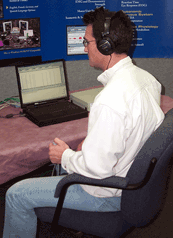H16 Reflexes & Reaction Time

This PRO Lesson describes basic reflex and reaction time (visual stimulus) exercises and details hardware and software setup of the BSL Lessons System to record reaction time to auditory stimulus. All data collection and analysis is done via the BIOPAC MP3x data acquisition unit and the Biopac Student Lab Lessons software.
Experimental Objectives
-
Measure reflex response of the femoral, medial popliteal, musculocutaneous and radial nerves.
-
Measure reaction time to visual stimulus.
-
Observe the effects of learning and physiological processes on reaction times of auditory stimulus.
-
Compare reaction times with two presentation schedules: fixed intervals and pseudo-random intervals of auditory stimulus.
-
Design an experiment to determine factors that affect reaction time and indicate specifically where in the nervous system sequence a factor had its effect.
Tasks Performed by the Student
- perform muscle reflex exercises,
- visual stimulus exercises, and
- auditory stimulus exercises.
Videos
Biopac Student Lab Student Download
Student Prep & Distance Learning
Click the link(s) below for sample data and/or lesson procedure video(s), BSL PRO Lesson procedures (PDF) for human lessons*, and graph template files (*.gtl) for BSL PRO Lessons. If more than one .gtl is available, download the .gtl with the _suffix to match BSL version and hardware.
Lesson Hardware
This lesson requires a Biopac Student Lab (BSL) System and the following hardware. If your BSL System does not include all hardware items, expand your system by selecting required items below. For more details, review the Lesson: L# BSL Lessons - see the Lab Manual or launch BSL; A# and H# BSL PRO Lessons, click the PDF link above to review full setup, recording, and analysis procedures.
| Item | Name | Cart |
|---|---|---|
| SS10L | Push Button Hand Switch - MP3X/45 | Add to Cart |
| OUT1A | Headphones to MP36/MP36R output port | Add to Cart |
Stay Connected